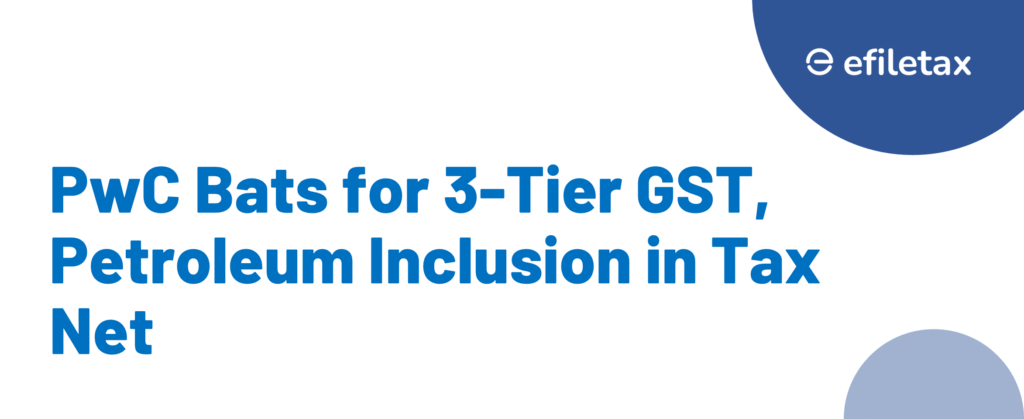
PwC India Calls for Overhaul in GST Three-Tier Rates & Petrol Inclusion
The Goods and Services Tax (GST) has been India’s most significant indirect tax reform. However, even after seven years, complexities remain — from rate disputes to tax exclusions like petroleum. Now, a PwC India report proposes a bold move: adopt a three-tier GST rate structure and bring petroleum products under GST.
Let’s break down what this means for Indian taxpayers, businesses, and policymakers.
Why Talk About a New GST Structure?
Currently, GST has multiple slabs: 0%, 5%, 12%, 18%, and 28%. There are also exemptions and compensation cess on items like luxury goods and sin goods.
PwC’s proposal suggests simplifying this into just three slabs — which can significantly:
- Reduce classification disputes
- Improve compliance
- Enhance ease of doing business
- Widen the tax base
Key Highlights of PwC’s GST Proposal
Here’s a snapshot of what the PwC India report recommends:
| Parameter | Existing GST System | Proposed by PwC |
|---|---|---|
| Number of Slabs | 5+ (0%, 5%, 12%, 18%, 28% + cess) | 3 Slabs (e.g., 8%, 15%, 30%) |
| Petroleum Products | Outside GST; taxed under VAT & excise | Bring under GST |
| Revenue Compensation | State compensation till June 2022 | Align rates to reduce compensation |
| Ease of Classification | Multiple disputes & litigation | Simplified categories |
Focus Keyphrase: GST rate structure
Bringing Petrol and Diesel Under GST: Why It Matters
India currently taxes petrol and diesel outside GST. States apply VAT, and the Centre imposes excise duty — leading to high retail prices.
PwC suggests:
- Including petroleum products under GST would standardise taxation
- Help consumers via lower fuel prices in the long term
- Cut tax cascading in logistics and manufacturing
Legal Angle:
Under Article 279A(5) of the Constitution, the GST Council has the power to recommend inclusion of petroleum products. However, no decision has been made yet.
Expert View: One Nation, One Tax Needs Uniformity
Tax experts believe the current structure defies GST’s core objective. A former CBIC official noted that:
“A simpler GST rate structure, with inclusion of fuel, can end classification chaos and reduce tax evasion significantly.”
This perspective is echoed by industry leaders who face compliance burdens due to differential tax treatments.
Potential Benefits of a Three-Tier GST Rate Structure
- ✅ Simplicity: Easy classification, fewer disputes
- ✅ Compliance: Reduced litigation and notices
- ✅ Revenue: Wider base through fuel inclusion
- ✅ Growth: Boosts investor confidence and logistics
Challenges Ahead
Despite its benefits, implementation won’t be easy:
- States may resist due to revenue concerns
- Need for political consensus in GST Council
- Risk of short-term revenue dips
But with proper compensation mechanisms, transition frameworks, and data-backed reforms, this overhaul could reshape India’s indirect tax regime.
What Happens Next?
The GST Council — comprising Union FM and State FMs — holds the key. Any structural change needs their collective approval.
Meanwhile, businesses and taxpayers should:
- Stay updated on GST Council meeting outcomes
- Assess sector-wise impacts if petroleum products come under GST
- Review contracts and pricing models in anticipation of slab changes
FAQs on GST Rate Structure Reform
Q1: Who decides GST rate changes?
The GST Council, as per Article 279A, decides on rate changes.
Q2: Will petrol prices reduce under GST?
Potentially yes. If fuel is taxed at 28% GST instead of current VAT + excise, consumer prices may reduce.
Q3: Why haven’t petroleum products been included yet?
States fear loss of revenue, which delays consensus in the Council.
Summary
PwC India recommends a 3-tier GST rate structure and inclusion of petroleum products under GST to improve transparency, reduce litigation, and simplify India’s indirect tax system.
Final Thoughts
India’s tax system stands at a crucial crossroads. If PwC India’s recommendations are adopted, the GST rate structure could become simpler, more uniform, and inclusive — aligning better with the vision of “One Nation, One Tax.”
📌 Need help navigating GST compliance or structuring your business for future tax reforms?
👉 Talk to Efiletax Experts